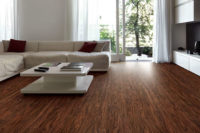Laminate Flooring Adds Realism With New Formats, Designs

Mohawk’s Barrington laminate flooring.
Laminate flooring is finding new ways to mimic the looks of hardwood and tile/stone flooring, from improved printing technologies to more modular formats. The category runs the gamut from rustic hardwood visuals and distressed textures to multi-direction ceramic/stone looks and thin grout lines. Many manufacturers also believe that custom designs might not be too far off in the future.
According to Jeff Katz, Tarkett’s director of laminates, North America, a wide range of laminate flooring is attracting consumers. “Laminate designs with value-added features continue to capture more share in the category,” he said. Among the bestsellers are narrow width planks with beveled edges and realistic embossing, Katz noted.

Formica Flooring’s Messina in Abilene Oak, from Kronotex USA.
He added that high-clarity, high-gloss finishes (also known as “piano finishes”) remain popular in laminate flooring, and hardwood looks on longer, wider planks (about 7’ long and 8” wide) are also trending upward. He believes that consumers are looking for laminate flooring that emulates the real material as closely as possible. “So our emphasis is to make the product look incredibly real,” Sheehan said.

Pergo’s new Fleming Oak décor, part of its Elegant Expressions line.
He added that Mohawk and Quick-Step’s GenuEdge Technology is aimed at increasing that sense of realism. “The new GenuEdge Technology allows the plank’s surface design and color to literally roll over the edge, creating the same edge visual found in a real wood plank.”
Armstrong is among the manufacturers that are offering long plank formats. Milton Goodwin, Armstrong’s vp laminate and ceramic products, said that often, consumers are looking for value propositions in their laminate floors. “These products are very expensive in real wood and can have issues in installation. But in laminate, it’s a great installation story and the products look absolutely beautiful.”

Tarkett Trends laminate flooring.
Kevin Roy, Quality Craft home improvement products’ Pacific Northwest regional manager, said another reason laminate flooring sells is that it can be a forgiving floor. “One trend we’re seeing with consumers is an increase in distressed looks. Builders are catching onto that distressed look, too. I think it’s simply because distressed floors are great at hiding scratches and dents. You could drop a pipe wrench on the floor and nobody would know.”
Offering the proper colors to match consumers’ moods is also important to the laminate flooring mix, said Travis Bass, Kronotex USA’s exec. vp sales and marketing. “During the tough economic times, we have seen a moderate retreat to the basic designs, but with brighter, fresher colors.” He said consumers find “comfort … and natural optimism” is these types of designs.
Kronotex announced last August that it was investing $45 million to expand operations at its plant in Barnwell, S.C. According to Bass, the expanded plant will incorporate the latest technological capabilities for creating products ranging from “plain to fancy.”

Pictured is Mannington’s Aberdeen flooring in the color of Driftwood, from the company’s Longwood collection.
He also points to enhanced realism through higher-quality décor papers and deeper textures as selling points. “Faus recently introduced our latest technology, Convex Surface, which recreates the natural effect of a wooden surface worn away by usage and the passing of time.” Carballo added that slate, tile and stone designs with more realism are also capturing interest.
Tony Sturrus, Clarion Industries’ president and ceo, agreed that realism is one of the main focuses for manufacturers and consumers alike. “Designers are interpreting this trend by delivering richer, dimensional new product designs in the laminate flooring category,” he said. “There have been measureable enhancements in surface technologies to support the elements of realism, as well as advances made to improve product performance, durability and scratch resistance.”

Cottage Slate Biscotti from the Fausfloor laminate flooring collection.
The Future of Laminate Flooring
Pergo is anticipating an increased focus on realistic looks, and plans to launch Natural Variations technology in 2011. “Typical laminate décor offerings feature approximately 10 different plank varieties, but Natural Variations will increase the numbers of varieties to hundreds,” said David Hartman, Pergo’s vp sales. He added that the technology uses a patent-pending process that allows for a greater number of color and design variations.Sheehan said that Mannington will begin migrating some of its technologies from its Best category to its Better category next year. “It’s time to reinvigorate and rejuvenate the middle price point.”
Armstrong’s Goodwin sees print technologies improving to the point that “they will start to blur the lines between what is laminate and what is engineered wood or micro-veneered products.”

Weathered Way laminate flooring from Armstrong.
Some manufacturers also believe that custom floors may not be too far off in laminate’s future.
“In the near future when digital printing technology becomes a reasonable option at the manufacturing level, manufacturers will have the ability to create their designs in house, reducing the time from creation to manufacturing significantly,” Faus’ Carballo said. He added that these types of enhancements could make custom flooring in laminate a reality.

Marseille Maple, part of Quick-Step’s Veresque collection.
Roy said custom floors will only happen “if the custom laminate floor is as cost-efficient to make as a regular laminate floor.”
Sturrus noted that laminate floors are likely to transition to custom options in the near future, because the nature of the category is to innovate. “The category is doing an excellent job of optimizing features and driving demand … Customization will provide solutions and retail applications at competitive costs.”
Looking for a reprint of this article?
From high-res PDFs to custom plaques, order your copy today!




